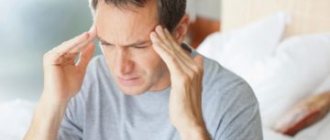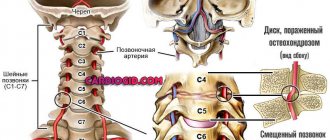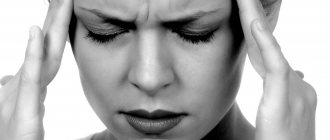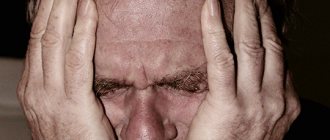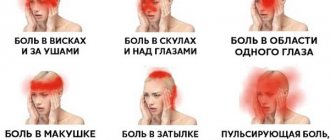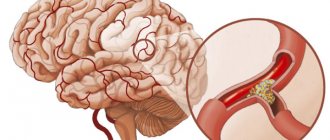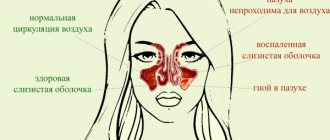You have come for important information and now let’s talk about Headache (psychosomatics): causes of migraine. Maybe in your case it was different, but we’ll tell you how it usually happens. Attention, before prescribing diagnoses or medications/treatment for yourself, you should always consult with professional specialists in your field and not self-medicate. Of course, you can quickly find the answer to the simplest questions and diagnose yourself at home. Write your wishes in the comments, together we will improve and supplement the quality of the material provided.
The result of exposure to external stimuli
So, psychomatic headaches are associated with the influence of external factors, but have the same symptoms as somatic (internal) ones. Thus, the body cries out for help, not wanting to put up with conditions of constant stress. If you live under pressure and often enter into conflict situations, be prepared to live with a constant side effect in the form of migraines. But if you can’t change the stressful and dynamic working conditions of a modern person, then you can cope with the flow of negative influence pouring out on us from the media. Just stop monitoring world news and watching political programs on television.
How to eliminate symptoms?
The main topic of our conversation today is psychosomatics, headaches, and the causes of its occurrence. If three quarters of the population suffer from migraines from time to time, and most of the causes of the disease are psychological in nature, it is reasonable to ask the question: how to deal with it? First of all, you need to understand that the problem lies somewhere deep. You can’t get rid of it with a click or wave of a magic wand.
Favorable living conditions are what will relieve painful headaches. Then it is necessary to harmonize the inner worldview and consciousness. You can forget about existing problems if you redirect the accumulated negative energy into a positive direction. So be patient and do some serious work. It's worth it, because life without headaches is doubly wonderful!
Headache is a consequence of communication problems
The easiest way to get an idea of how the headache defense mechanism manifests itself is by talking to a person who is unpleasant to you. At the same time, the situation obliges you to smile and say good words to him. At such a moment, one hemisphere of the brain reacts sensitively to internal discomfort associated with communication. The other habitually builds a model of behavior corresponding to the external situation. As a result, some head muscles remain relaxed, while others become tense. This imbalance of feelings, thoughts-images and physiological reflexes manifests itself in characteristic painful spasms. The protection works flawlessly.
Naturally, man is a social being and we cannot completely isolate ourselves from unnecessary communication, when we encounter a variety of people every day. But it is within our power, if not to avoid it completely, then to reduce such communication to a minimum.
If you don’t have to choose a job and you still need to communicate, you should try to analyze why this person appeared in your life. After all, if you react so sharply to what you don’t like about someone, then you certainly have that something too. A headache gives you the opportunity to look at your shortcomings visually, “from the outside.” Having realized what exactly is unpleasant for you, all that remains is to eliminate it in yourself. This way you will automatically get rid of the feeling of hostility towards the person and the situation, and with it, the headache.
Example: a woman suffering from constant headaches complains to a psychotherapist about her boss. Communication with her boss was accompanied by acute migraine attacks every time, and she had no opportunity to change jobs. The key to the problem turned out to be long-standing grievances against the boss and a situation from the distant past, when a man very similar to the boss treated a woman rudely and dishonestly. Internal depression, long-standing grievances and self-flagellation at some stage crossed the red line, her internal censor signaled through the body with a headache. Having changed her attitude towards herself, towards the past, and towards the situation as a whole, she was soon able to forget about her problem, establish a relationship with her boss, who “unexpectedly” saw the light and saw in her a valuable and talented employee.
The process of triggering a migraine (psychosomatics)
Headache is formed as a response of the body to external, sometimes even minor, stimuli. At the moment of shock or stressful situation, blood pressure instantly increases. The walls of blood vessels are compressed, which cannot but affect the brain. Against the background of external stimuli, intracranial pressure increases and metabolism in the body is disrupted. When all these factors come together, migraine pain appears, literally occupying part of the head.
Do you trust doctors and their prescriptions?
Yes
20.21%
No
11.4%
I trust, but I check all medications for reviews on the Internet from people who have already tried them and only then do I start taking them.
51.81%
Yes, but only to appointments and doctors from paid clinics.
16.58%
Votes: 193
People who experience shock, anger, or fear react with obvious physical symptoms such as hot flashes, redness of the skin, or paleness. All these manifestations indicate a vascular reaction to the release of adrenaline. In this case, it is not necessary to bring yourself to nervous exhaustion; one negative thought is enough. So, we have already seen that psychosomatics plays an important role in the occurrence of physical illness. A headache is just the body’s reaction to the influence of external psychological factors.
People who experience shock, anger, or fear react with obvious physical symptoms such as hot flashes, redness of the skin, or paleness. All these manifestations indicate a vascular reaction to the release of adrenaline. In this case, it is not necessary to bring yourself to nervous exhaustion; one negative thought is enough. So, we have already seen that psychosomatics plays an important role in the occurrence of physical illness. A headache is just the body’s reaction to the influence of external psychological factors.
Fear
Fear is inherent in every inhabitant of the planet, but not everyone copes with it without serious problems from a psychosomatic point of view. This is a strong shock to the psycho-emotional state.
Contact a psychologist
If attacks happen more and more often, and it becomes harder to deal with them, then only a psychologist will help you deal with them. The specialist will competently assess the patient’s life situation, position, etc.
Based on the analysis obtained, he will find out why there is a problem and create adequate therapy that will be aimed at solving the problems.
Low self-esteem and self-criticism
One of the metaphysical causes of migraines is self-esteem. Healthy self-criticism is one of the fundamental principles of achieving desired results. However, low self-esteem is not at all positive.
Those who are dissatisfied with themselves have constant nervousness, neglect of health and appearance, difficulties in making simple decisions, suspicion and distrust. This is where the reluctance to live arises; the person himself starts the process of self-destruction.
Treatment of attacks
Therapy should only be prescribed by doctors. Taking strong migraine pills can cause nausea and vomiting, and large doses can be fatal.
| Ibuprofen | Universal anti-inflammatory, antipyretic, analgesic |
| Solpadeine | Strong painkiller |
| Nomigren | A drug intended only for the treatment of migraines |
| Zomig | Prescribed for the relief and prevention of attacks |
| Relpax | Prescribed for the relief and prevention of attacks |
Be sure to discuss the risks with your doctor before taking headache medications.
Some are inclined to think that responsible, ambitious, striving for perfection, and anxious people are also susceptible to attacks. All experiences and emotional shocks are not so easily tolerated, and the body does not cope well with a stressful situation.
The effectiveness of drug treatment for migraine (or rather, pain relief) is within 60%.
Today, the causes of the disease have not been definitively established; the leading theory is trigeminovascular, which combines neuronal and vascular mechanisms of migraine formation. The theory explains migraine as a biochemical disorder of the mechanisms of interaction between the vessels of the head, the trigeminal nerve and the central nervous system, which in turn leads to inflammatory processes in the blood vessels.
As a consequence of migraine, a person loses his ability to work for a day or more.
The frequency of such attacks varies - from several per month to 1-2 per year.
Improvement with the help of NPTsRIZ peptides
Series of articles. Continuation.
A complete catalog of psychosomatics of specific diseases with recommendations for their resolution at the mental level, using a cheat sheet for working with psychosomatics, and at the physiological level, using peptide products from NPTsRIZ.
The column is led by an aesthetic coach, neurography instructor, coach for achieving goals and self-development, theta practitioner, master of working with the genus Victoria Abdrakhmanova.
Physiology of migraine
A migraine is a headache that affects only one side of the head. Accompanying symptoms: nausea, possible vomiting. The duration of the attack can be from several hours to several days. With very severe attacks, vision and even speech may deteriorate.
Psychosomatics of migraine
The psychosomatics of migraine are associated with a strong feeling of guilt and a feeling of living in someone’s shadow. Such a person cannot openly speak out against a person who has a strong influence on him. Hence the feeling of guilt. He feels that he is uncomfortable in the current situation, he would like it differently, but he cannot say this freely and openly. This looks like a very strong internal block. It’s as if he’s being held by the tongue, and this creates physical tension in his head. As a result, a person feels completely helpless in such circumstances, and he has the feeling that he is not living his own life, but in the shadow of another person.
People who suffer from migraines have a hatred of subordination and coercion, there may be fear in intimate relationships, as well as resistance to the course of life.
Recommendations for solving the problem
The solution to migraine problems is to reconsider your self-perception. It is worth asking yourself the question: who do I want to be? And imagine what it would be like if circumstances were favorable. We need to figure out what is preventing this at the moment, what has caused the current situation until now. Well, then you need to plan your own further development in the area that causes difficulties, and best of all, harmoniously in all main areas: health, relationships, self-development and professional activity / money.
It is important to understand that each person has their own internal boundaries. And if other people violate them with their attitude, then these people should be returned to their place, building the integrity and inviolability of their boundaries. Of course, some will be within these boundaries, for example, close people, but others should not be allowed anywhere near.
It is necessary to remove fears in the sphere of intimate relationships. Freedom of self-expression, freedom to express your desires and feelings, as well as what is unpleasant, gives freedom in relationships with your sexual partner. And as a result, this reveals a person’s creative potential.
Settings that can help:
- I love life and I am interested in living.
- I am free from all negativity that ruins my life.
- I am free from any prejudices and fears. I solve any fears by planning for the future.
- I live an easy and relaxed life. I allow life to flow freely in my life and provide me with everything I need in a form that is acceptable to me.
- I freely and easily express my desires and feelings. I know how to say no.
- I easily find a common language with people who influence me. I always maintain my personal internal boundaries in an environmentally friendly manner.
Suggest your version of a positive attitude in the comments.
If a person is able to adequately answer questions, the Cheat Sheet for working with psychosomatics will also help solve the problem with this illness on a spiritual level. She takes you step by step to the main cause of the disease and opens up the possibility of how to improve your health and interaction with the world around you.
In addition to this, neuro-graphics can help. It allows you to relieve tension in an environmentally friendly way, level out blocking moments and create the desired state. It is built on the connection between the brain, central nervous system and hand motor skills.
More detailed information about this can be obtained from me personally. For this in the comments. Or write me a private message, so I will answer you much faster.
Is there some kind of psychological problem common to all people that causes migraine?
On the Internet, for the query “psychosomatics of migraine” you can find many ready-made explanations from: “inability to take care of your head” to: “accept your level of intelligence as secondary to the call of your heart.”
It’s confusing that there are so many interpretations, but the migraine continues to rage.
A person is unique in his combination of character traits, types of nervous processes, childhood and adult experiences, inherited concepts and behavior patterns.
What exactly caused nervous tension in a particular person can only be revealed by psychotherapeutic work with this particular person. For the same reason, the method of getting rid of tension, and therefore migraines, will be strictly individual!
However, it is typical for all people that a stress factor can be either an external situation (dismissal, quarrel, etc.) or internal experiences, internal conflict (rejection of one’s appearance, dissatisfaction with one’s chosen profession, etc.).
According to statistics, 90% of the inhabitants of our planet know what a headache is.
Very often people call any headache a migraine, but this is incorrect.
From a medical point of view, there are the following types of headaches:
- Primary headache - independent forms, which include migraine, tension headache and cluster headache;
- Secondary headache is a headache as a symptom of any established disease: inflammatory or infectious, traumatic brain injury, pathology.
Stress is not scary, but being “stuck” in its biochemical changes is scary.
Causes of migraine: a look from both sides
From a scientific point of view, the exact cause of migraine has not been established. More likely is limbic-stem dysfunction, which leads to a decrease in the background activity of the antinociceptive (anti-pain) and GABAergic systems. As a result, the blood vessels of the membranes and parenchyma of the brain become the implementing link of the attack. A predisposing factor for this is heredity.
The term psychosomatics means the occurrence of somatic (body-related) problems due to mental (mental) experiences of varying intensity.
Despite the deep scientific nature of this theory, it does not take into account the trigger mechanisms for the occurrence of migraine, the greater susceptibility of women to the disease, and the absence of visible organic changes when studying the brain of patients suffering from this disease.
In most cases, the cause of a migraine attack is strong negative emotions and chronic stress. From a practical point of view, psychosomatics most reliably indicates the factors leading to any attack of such a headache, and, accordingly, the methods of its treatment.
Psychological causes of attacks:
- In response to acute mental trauma, unpleasant news. As a replacement for resentment and anger. In this case, a psychosomatic headache arises as a result of a person’s understanding of his weakness, undervaluation, when he feels it is impossible to resolve a conflict situation. This is a peculiar form of mental blocking.
- As a consequence of a violation of personality development When a person, without objective external reasons, experiences disturbing or negative experiences.
- For a long-term stressful situation, persistent experiences, accompanied by activation of the sympathoadrenal system, the release of stress hormones into the blood and generalized vasospasm.
- For depression. This is how a psychosomatic migraine may arise, which is associated with internal conflicts. Most often, headaches of this nature require the help of specialists. Because it is a generally accepted fact that a person in a state of depression cannot get out of it on his own.
- As a symptom of endogenous nervousness and psychosis. These conditions are classified as mental disorders and are treated by psychiatrists in specialized clinics.
Important: Another popular type of headache is tension headache. It is characterized by a feeling of a squeezing “helmet on the head” and is more typical for men, when migraine affects mainly women. At the same time, psychosomatics also describes the main causes of tension headaches.
Since the most complete picture of a painful attack and its causes can be described using theories about the psychosomatics of migraine, we will consider the reasons for its occurrence, and, accordingly, approaches to treatment in more detail.
In men
Men are by nature less responsive to the perception of internal and external stimuli. Headaches in representatives of the stronger sex can be caused by other circumstances. But at the same time, we cannot exclude the causes of psychosomatics, which have an equally harmful effect on both.
- physical inactivity;
- hangover syndrome;
- smoking;
- Atmosphere pressure;
- premonition of bad weather;
- excess or lack of sleep.
You need to understand that a headache is not a cause, but a consequence of existing disorders in the body.
Pain as a consequence of low self-esteem
Many patients who turn to a psychotherapist show a strong relationship between the presence and intensity of headaches and the level of depression and anxiety. Headache is a common companion of a person who negatively evaluates himself and the world around him. It has been noticed that most people of this type developed a pessimistic outlook on life long before the manifestation of headaches on the physical level. Headaches are often provoked by grievances driven deep inside, a negative attitude towards parents, which turns into an acute feeling of guilt and inner emptiness.
Research by G. Nattero led to the conclusion that headaches often accompany people with a low level of emotional and social life, neglect of sexual relationships and extremely low self-esteem. A headache that develops against the background of depression, psychasthenia, hypochondria... is nothing more than a somatic expression of anxiety.
The key to solving the problem is reconsidering your attitude towards yourself, accepting yourself as we are, and the ability to notice only virtues in people. After all, what we are used to noticing in others is what they show us.
In the frontal part of the head
The localization of pain in psychosomatics, its nature, duration and other symptoms suggest the nature of the disease and how to cure it. If painful sensations overcome the frontal part of the head, we can assume an infectious, inflammatory nature of their origin. But for an accurate diagnosis you need to see a doctor.
This also includes increased intracranial pressure, pinching of the occipital nerve and other psychosomatic causes of cephalgia. Diseases of the autonomic and cardiovascular nervous system also cause pain in the front of the head.
Migraines can also cause pain in the frontal part of the head. But this complex phenomenon also has other characteristic symptoms.
Psychologists' opinion
Their observations show that headaches most often occur in people who react painfully to reality. These patients, as a rule, have inflated claims to the world, are ambitious, even arrogant.
Headaches often act as a kind of compensation for their desire to always and everywhere be the first, the best, and the successful. Perfectionism does a disservice, returning their stress to them in severe attacks. Psychologists strongly advise such sufferers to stop in their tireless movement forward and upward. Give yourself time to rest and restore resources.
This is not all, but the most common reasons that cause heavy sensation in different parts of the head in women. The causes of psychosomatics can also be: hypertension, hypotension and anemia, poor nutrition, lack of exercise and, of course, mental and emotional imbalance.
This statement has recently surprised almost no one and has found many supporters. The thinkers and healers of antiquity shared the same opinion.
Psychosomatics, a science at the intersection of medicine and psychology, believes that the connection between soul and body is so strong that unstable emotions and unbalanced human behavior lead to the appearance of diseases.
Causes of migraine according to psychosomatics
Renowned psychologist Louise Hay spent many years closely observing patients suffering from chronic migraines.
She analyzed the causes of recurring attacks and identified their connection with mental factors and stressful experiences. In her books, she suggested that patients with the following characteristics are most susceptible to the disease:
- overwhelming emotions and feelings;
- having feelings of guilt towards loved ones;
- suffering from unfulfilled desires.
Connecting the causes of migraines and psychosomatics, Louise Hay points out frequent attacks in people who are forced into relationships. The condition is worsened by working in a conflict team, suppressing anger or malice.
Philosopher Liz Burbo agrees with the American psychologist. Actively considering the manifestation of migraine and the psychosomatics of the disease, she traced the connection between the state of stress and exacerbation. Among the common causes of vascular pathology:
- phobias;
- prolonged depression;
- constant feeling of anxiety;
- lack of fulfillment in personal life and professional sphere.
According to the theory of Liz Burbo, the psychosomatics of migraine lies in the constant accumulation of negativity. It begins to put pressure from the inside, causing increased blood pressure, swelling and headaches.
The more depressed a person is, the more often attacks occur, and the disease becomes chronic. The situation explains the appearance of migraines in middle-aged men.
According to the psychosomatics of migraine, pain in the temporal region is more common in women who are perfectionists.
They set high goals for themselves and are constantly under pressure. Not getting the desired result, they engage in self-flagellation, which increases the state of stress.
Louise Hay table - what is it?
The stereotypes of our thinking are formed on the negative experiences a person has received. This postulate of psychosomatics and the table of diseases are closely related to each other.
If you change these old beliefs, you can completely get rid of many problems and illnesses. Each incorrect setting leads to the appearance of a specific disease:
- cancer is an old grudge;
- thrush - subconscious rejection of your sexual partner;
- cystitis – containment of negative emotions;
- Allergy – reluctance to accept something or someone into your life, perhaps even yourself;
- problems with the thyroid gland - dissatisfaction with the quality of life.
Louise Hay believes that the cause of the disease will disappear after a person realizes the emotional problem. The disease does not appear just like that; it is sent to every person so that he thinks about its psychological causes. Louise Hay's table is intended to facilitate these searches.
Reasons from a psychosomatic point of view
Migraine and its psychosomatics have been studied by many famous psychologists. They all agree that this disease is caused by emotional instability and internal unrest.
Liz Burbo, a Canadian philosopher and psychologist, in her scientific works argues that the development of the disease is provoked by emotional, mental and physical factors. Guilt towards loved ones, constant suppression of one’s own desires, psychological dependence on other people contribute to the appearance of physical symptoms of the disease. To get rid of a migraine, it is enough to stop restraining yourself, resisting desires and complexes, and depending on the opinions of others.
Louise Hay, a psychologist from the United States, believes that the disease is formed under the influence of dissatisfaction with the outside world, doing uninteresting things, fears, and dissatisfaction with sex life. By changing your attitude to the situation, you can get rid of the disease.
Here are the generally accepted psychosomatic reasons that explain the occurrence of a migraine attack, accompanied by impaired blood flow through the cerebral vessels, painful headaches, and neurological symptoms:
- suppression of anger, anger;
- increased demands on people around you and specifically on yourself;
- inability to forgive insults;
- suspiciousness without reason;
- complexes, phobias;
- depression;
- stress.
A person who knows first-hand what a migraine is is very afraid of a repeat attack. In fear of pain, he stops communicating with loved ones, does not attend public events, avoids large crowds of people, focusing on his illness. Such behavior leads to the fact that the patient withdraws due to his psychological problems, which are precisely the provoking factors of migraine attacks, which are occurring more and more often.
Personality type prone to migraines
Most often, migraine attacks affect people in whom intellect and rationalism prevail over emotions. These people are characterized by the following qualities and character traits:
- tendency towards ambition; heightened sense of self-esteem; the desire to control the situation, to compete with others in business and personal life; secrecy, restraint in emotions; touchiness, resentment; hidden claims towards oneself and the imperfect surrounding world; painful reaction to humor; dissatisfaction with the realities of life and, at the same time, a lack of desire to change everything for the better.
How to overcome the disease?
- Accept information about the imperfections of the world and yourself. Do not be upset if planned events did not take place on time or unforeseen circumstances occurred.
- Reduce the level of demands on yourself and the environment. It is necessary to get rid of the idea that one’s own absence or inaction will lead to catastrophic consequences, and that the planet will then stop spinning around its axis.
- Learn to recognize negative emotions and eliminate them. First of all, you should learn to admit to yourself that certain actions or factors cause anger, rage, and aggression. To adequately assess the information, the situation that caused negative feelings should be described on paper. This will allow you to understand the cause of irritation, find positive aspects in it and switch to them.
- Recognize stress and prevent its transition to the chronic stage. Before starting psychotherapy, the cause of the stressful situation should be eliminated or minimized. It is best to get rid of the consequences of nervous tension through physical activity, be it sports, active recreation or work in the country.
- Communicate only with positively minded people. This will allow you to be charged with positive energy, strive for spiritual and personal development, and experience positive emotions.
- Love yourself and not adapt to the opinions of others. Don't get hung up on each person's opinion of themselves. You need to show all your qualities and skills, engage in your favorite pastime, while not forgetting about the rules of decency.
Describe your problem to us, or share your life experience in treating the disease, or ask for advice! Tell us about yourself right here on the site. Your problem will not go unnoticed, and your experience will help someone! Write >>
Recording the events preceding a migraine attack will help you understand the causes and factors that provoke migraine. The recordings made will allow us to identify psychological factors that provoke pain attacks and subsequently eliminate their impact.
The information on the site is created for those who need a qualified specialist, without disturbing the usual rhythm of their own lives.
A migraine attack can be provoked by stress and psychological turmoil, as well as one of the following psychosomatic disorders and conditions:
Let's work together to make the unique material even better, and after reading it, we ask you to repost it on a social network convenient for you. net.
Headache and psychosomatics
Each organ or system of our body is not just a workshop responsible for performing some physiological functions and processes.
At the information-energetic level, our organs and systems bear a very specific emotional load. The head is responsible for the thinking process. At the same time, problems with the head are a reaction to an imbalance between feelings and reason. Often, a headache signals us about the progression of some disease - cervical osteochondrosis, radiculitis, inflammation of the paranasal sinuses, phronitis, sinusitis and many others. But most often, pain is a persistent warning from our unconscious that something in behavior, thoughts or relationships has gone wrong. According to recent studies, the main cause of tension headaches not associated with intracranial and other diseases is psychosomatic disorders. And they are the main cause of headaches in 80% of the world's population.
Dr. Sinelnikov's simple advice will help you identify common causes of headaches and get rid of obsessive symptoms.

